Opening Glen Canyon
Air Date: Week of June 10, 2016
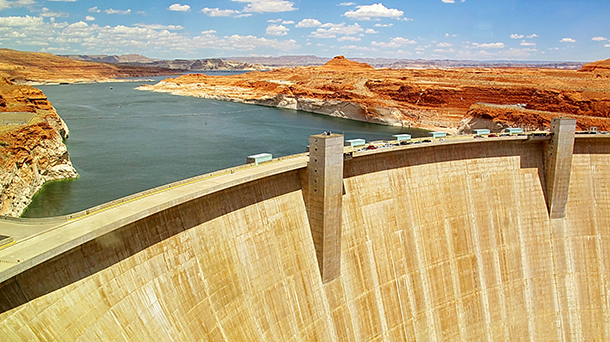
Lake Powell behind the Glen Canyon Dam (Photo: Alan English, Fickr CC BY-NC 2.0)
Searing drought is causing people to rethink water infrastructure in the West, including some of the major dams along the Colorado River. ProPublica Reporter Abrahm Lustgarten talks to host Steve Curwood about a new plan to open the gates of the Glen Canyon dam to save massive amounts of water lost to leaks and evaporation.
Transcript
CURWOOD: It's Living on Earth, I'm Steve Curwood. Searing drought has sparked soul-searching about water management in the arid West, and some now question the viability of dams and other infrastructure to supply water to cities and farms throughout the region. Abrahm Lustgarten is a reporter for ProPublica, and he has a new story about one of the largest dams in the US, Glen Canyon, and a recent push to open up its gates. It’s a remarkable development, given how important the Colorado River dams—Glen Canyon with its reservoir Lake Powell and Hoover with its reservoir Lake Meade—have been for the development of the West. Abrahm Lustgarten joins us now to talk about the story, welcome back to Living on Earth, Abrahm.
LUSTGARTEN: Hi there. Thanks for having me.
CURWOOD: First of all, for someone who has never seen it, what's the Glen Canyon Dam like?
LUSTGARTEN: The Glen Canyon Dam is a huge, impressive really awe-inspiring structure. Like the Hoover, which looks very similar, it's about 700 feet tall, it fills a very tight dramatic canyon in the Colorado River and you can come to a viewpoint or drive across the road right in front of it. So you have this, it’s almost like you're hovering in a helicopter. You get to look down on the lake and look down the dam and it's just this massive plug of concrete.
CURWOOD: So take us back to the time when the Glen Canyon Dam was first built. What was the attitude about dams back then?
LUSTGARTEN: So, Glen Canyon Dam was built in the 1950s, and the US was in the middle of a real dam building spree in the western United States. Starting in that early 1900s, 1920s, they started building dams up and down the Colorado River in particular to harness that resource and find a way to distribute it far outside of the river's natural course—hundreds of miles into Arizona, hundreds of miles into California and also to control some of the flood torrents that could come downstream in big water years. The Glen Canyon dam was built kind of the tail end of that spree after number of other dams had been built and it had more of a political aim. The upper basin states in the Colorado River - Wyoming, Colorado New Mexico, and Utah - they were worried that the lower basin states - California and Arizona, Nevada - were taking too much water, were growing too fast and they basically wanted a gate, and Glen Canyon Dam was built as their way to hold back water so they wouldn't have to give more than they were legally required to those states in the south.
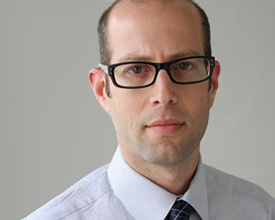
Journalist Abrahm Lustgarten (Photo: Lars Klove)
CURWOOD: Now, how essential have the Glen Canyon dam and the other megadams on the Colorado been over the years for the water supply of the west and southwest?
LUSTGARTEN: I don't think you would see a western United States that you recognize if it were not for, at least the Hoover Dam, if not both of those two dams being constructed. The Hoover Dam in particular stemmed an enormous flow of huge floods that would come down through Arizona and the southern tip of California on a regular basis, very difficult for those other agricultural areas to manage, very difficult to capture and use that water. So the Hoover Dam served a really clear purpose in terms of both generation of power and then creating a water reserve. Lake Powell essentially created another enormous water reserve, created an enormous generator of power when that reservoir was full. It's less of a flood control purpose, but what it did is gave the seven states a way to kind of regulate their agreements between one another as the big cities in the west grew. So as Los Angeles and Phoenix and Tempe and Denver all started competing more and more for that water, that gateway function that I described became more important and Glen Canyon really the regulator for this giant system.
CURWOOD: And just to remind people of the geography here, the lake behind the Glen Canyon dam is called Lake Powell. The impoundment behind the Hoover Dam is called Lake Mead. Now, David Brower was the first executive director of the Sierra Club and he's famously quoted as saying, agreeing to the Glen Canyon dam construction was his biggest regret. Why did he agree to it and why did he come to quickly regret his decision?
LUSTGARTEN: On the list of dams that the US Bureau of Reclamation was building was a proposed site at a place called Dinosaur National Monument and that's in northwestern Colorado and it was an established park. It's really phenomenal place, full of dinosaur bones and fossils and a lot of really rich history and that was a place that everyone knew, and David Brower knew and they fought hard to protect it. And through that really lengthy environmental fight they reached an agreement that they would not build a dam at Dinosaur National Monument, but the environmentalists wouldn't oppose a dam at another site, which was at Glen Canyon. And David Brower lived in Berkeley, California, and wasn't familiar with Glen Canyon, and he didn't have a sense of its majesty, and it was only later after he did come to make that tacit political agreement that he did visit Glen Canyon and he traveled it with the photographer Elliot Porter and they published this incredible book called "The Place No One Knew" and then before the dam was built but after everything was in process he began to oppose that dam site.
CURWOOD: Yeah, I mean, of course, Glen Canyon is famously located just upstream from the Grand Canyon. It's amazing territory.
LUSTGARTEN: Just 20 miles north of the Grand Canyon or upriver from the Grand Canyon, really the moment you're below the dam structure itself at Glen Canyon you're entering what you would recognize as the Grand Canyon.
CURWOOD: We have a recording of David Brower talking about his visit to Glen Canyon and his inability to block the dam. This is from the 1997 documentary film series "Water and the Transformation of Nature".
BROWER: I've seen the canyon, and I've seen the side canyons, my family had seen them and I knew what a beautiful place it was. I testified in the lack of comprehensive thinking that had gone on in the entire project and came up very strong arguments for stopping the entire project. And I wanted at least at the last moment to appeal to Stewart Udall and I wanted to get in to talk to him because that was the last day they're going to close the gates and start filling Glen Canyon. And I got to his office but never got to see him because he had this other agenda. I did have this last desperate hope that we could stay the closing of the dam, the closing of the river valves and stop any further filling until we thought a little bit harder about the alternatives. And that January of '63, I failed.
CURWOOD: Stewart Udall was a Democratic congressman from Arizona and later Secretary of the Interior. Despite protests, Glen Canyon was built, adding another dam to the Colorado River, which already had the largest one in North America, the Hoover Dam. But in recent years activists have started to point out that many dams have outlived their benefits. Dams have now come down on many rivers including the Elwha in Oregon and soon they'll be decommissioned on the Klamath, which runs between Oregon and Northern California. And given the changing weather patterns people are now even talking about opening up the gates of the Glen Canyon dam. Abrahm Lustgarten says each of these situations is unique.
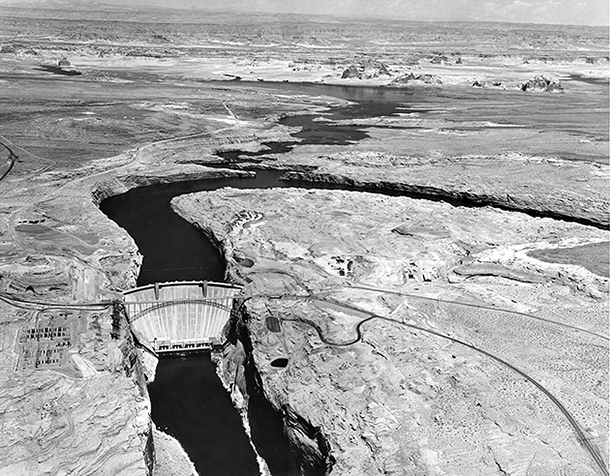
Aerial view of Glen Canyon Dam and Wahweap Basin of Lake Powell. (Photo: Bureau of Reclamation)
LUSTGARTEN: The circumstances of dams are very specific to their local geography and each faces different issues. In the northwest, the problem is the interruption of salmon migration, a really substantial ecological impacts. The Colorado River, it's a really different situation. There are endangered fish species in the Grand Canyon, but it's not as much as a question of the lost landscape of Glen Canyon, the damage for Grand Canyon of having unnatural flows through that river, and most significant to me the great inefficiency in terms of the water that's lost off the surface of these dams. The big dams on the Colorado River were built to save water, and what happens is because the water is spread over such a large area in such a hot and dry environment, an enormous amount evaporates off the surface and that didn't matter so much in the past but as waters become more and more scarce that amount of water that's lost is significant enough to make a real difference.
CURWOOD: Just how much is lost that way?
LUSTGARTEN: So, Lake Powell loses about 350,000 acre feet of water each year to evaporation and that's enough when you combine it with the amount of water that also seeps out the bottom of Lake Powell, another form of loss, it’s enough to supply about nine million people with water each year, about the size of the city of Los Angeles. Lake Mead also loses a similar amount and so does each of the reservoirs up and down the Colorado River system. When you add all that up together in a system that is over-allocated every single year, you basically see an inefficiency that could add roughly 30 percent more to the river's flow.
CURWOOD: So, how could that efficiency be addressed? If you take down the dams, it would seem you lose control of the water and yet if you have a dam with a lake behind it, it's going to evaporate. Seems like it's kind of a Hobson’s choice there.
LUSTGARTEN: Well, you're right except for the fact that both Lake Powell and Lake Mead are in a dilemma that they haven't been in since they've been created, and that is they're both essentially drying up. So for the last 16 years we've had unusually low flows in the Colorado River yet those states of continue to take their full allotment out of the river every year and essentially been drawing on those two huge reservoirs as a savings account and those savings accounts are almost drained. Lake Mead is now about 37 percent full. Lake Powell is just a little bit less than half full. Both reservoirs still lose an enormous amount to evaporation but they're not functioning at their full capacity, both in terms of the power to generate or the amount of water that they hold. So the ratio of inefficiency to benefit has just changed substantially over the last decade or so of drought.
CURWOOD: So Abrahm, what's the case for taking down the Glen Canyon Dam?
LUSTGARTEN: Well, the proposal to get rid of Glen Canyon Dam comes from the Glen Canyon Institute. It's an environmental organization. They've had a bias from the earliest days with David Brower towards restoring Glen Canyon but now they have a real pragmatic force behind their argument, and what they're essentially proposing to do is combine the two reservoirs. If they're both half-full their proposal is to empty Lake Mead, combine it with Lake Powell, not lose that water but send it 300 miles downstream and recollect it so you have one full large reservoir. You significantly decrease the amount of water lost to evaporation because you've decreased the total surface area that's exposed to the elements. You increase the power generating capacity of Hoover Dam which helps make up for what you lose in terms of power generation at Glen Canyon dam and a nice little a side effect bonus is the opportunity to actually restore the landscape of Glen Canyon.
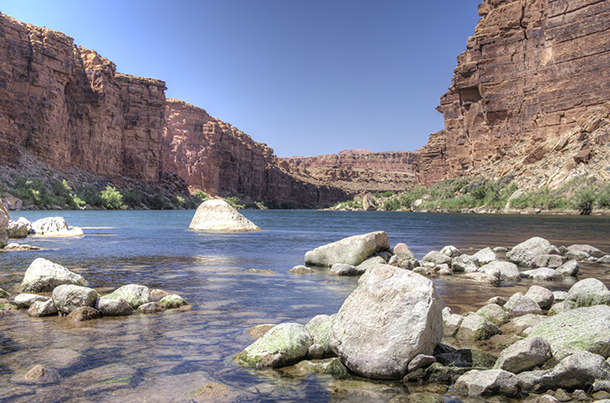
The Colorado River (Photo: Denny Armstrong, Flickr CC BY 2.0)
CURWOOD: Now why would Lake Mead be more watertight than Lake Powell?
LUSTGARTEN: It's just a factor of the local geology. The valley that Lake Mead filled is not one that geologists just have found to absorb a very large amount of water and to siphon that water away from that geologic basin that it sits in. Lake Powell on the other hand sits in a geologic basin that's full of very porous sandstone, a different kind of sandstone from Lake Mead and lots of cracks and fissures. And for a long time it was believed and the Bureau of Reclamation still believes that water seeped into the ground but eventually returned to the Colorado River. I was looking at some research, fairly new research from the last couple of years that's examining where those hydrologic gradients go and determined that the water isn't returning to Lake Powell, that about 380,000 acre feet again, an enormous amount of water is permanently lost each year out of the bottom of Lake Powell.
CURWOOD: So one of the reasons of course that the Glen Canyon Dam went up, you wrote about is that it allowed the states further upstream, communities further upstream, to have more control over water. How are they going to feel about the water going 300 miles away and out of their direct control?
LUSTGARTEN: Well, that's the big fight right there, I mean, most of the resistance to this idea, or the scoffing even that this idea is coming from those northern states and what they see is a political threat more than anything. They say that the existence of Glen Canyon Dam is the mechanism that allows them to comply with what's called the Colorado River compact and that's this legal agreement to send seven and a half million acre feet of water down to the south every single year and they say that if they don't have that dam there that they won't be able to meet that obligation. So in the most reactionary of terms they described the suggestion of removing Glen Canyon Dam as something that would require a renegotiation of that compact agreement, probably congressional approval and really involved bureaucratic process. What it basically means is that they don't want to lose that hands-on control over their water. Legal experts I spoke with, however, suggest that both the upper and lower basins could share the water out of Lake Mead. It doesn't have to continue in the traditional role of serving only the southern basins and that the accounting for that water could still happen at a place called Lee's Ferry where it happens now which is just below the site of the Glen Canyon Dam.
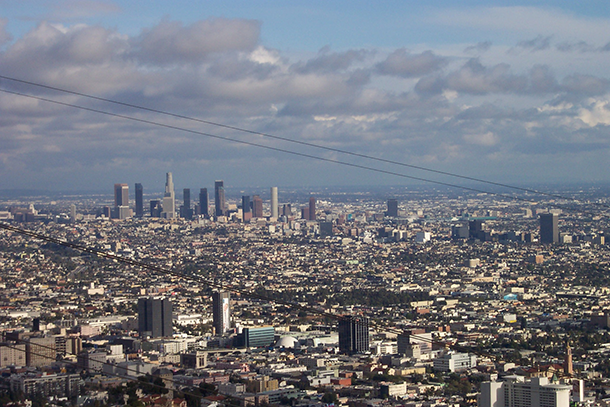
Water infrastructure along the Colorado enabled the development of large Western cities including Los Angeles (Photo: David Galvan, Flickr CC BY NC ND 2.0)
CURWOOD: My guest is ProPublica’s Abrahm Lustgarten, who’s been writing about how the changing climate is throwing doubt on the value of megadams. So how realistic is it to think of opening the gates of the Glen Canyon dam, in the face of political pressure from states upstream?
LUSTGARTEN: So this is the question that I posed to the deputy secretary of interior Mike Connor and he's ultimately the person charge of water in the west and the short-term answer is that it's not realistic. This is probably not something that's about to happen, but what we see through the removal of dams across the western United States, whether it's on the Klamath or elsewhere and there were five, six dams removed just in the last year is that the idea of a dam not suiting its original purpose is a topic that can now be broached. So when water managers look at the Colorado River basin and how to manage the extreme deficits there, really for the first time ever at least this is part of the conversation and that's, that's what I'm seeing change. Whether things get dire enough, whether as I put in the article those western states decide they need the water badly enough to actually take the dam down, I think that remains to be seen, I think it'll take some time. But this is a conversation that was laughable a couple years ago and now at least is taking place in a very serious way.
CURWOOD: With all this talk to decommission the Glen Canyon Dam, that is to let it drain, what would happen if nothing is done?
LUSTGARTEN: If nothing is done at all, then the future really depends on how much water flows into the river and how much water the states continue to take out of it. The bottom line is the Colorado River will never be sustainable until the amount of water the states take from it matches what is naturally available. If that doesn’t change, if the states continue to draw every single year more water than flows out of it, than these reservoirs are going to drain. It could take another ten years it could take two years but they’re going to drain to the bottom. Researchers at Scripps School of Oceanography at UC San Diego predict that there is a 50% chance that Lake Meade will run dry by 2021. So this is in a way inevitable. So we’ll see this proposal to save Glen Canyon happen one way or another, whether it’s the result of a political decision and the renegotiation of the river compact, or just the result of a diminishing supply of water and it eventually draining down to a small puddle in the bottom. The alternative is what you see California and Arizona and Nevada working towards now. Not quite a renegotiation of the compact but an agreement to take less water. They’ve got a long ways to go. They’ve got to take far less water than even this agreement would allow them to take. But if you can reach a point where states are happy to use only the amount that’s available, or perhaps their share is proportional to the amount of water that is available in any given year, then you could see a system where the flows could once again be regulated and governed and these reservoirs might serve a purpose because the draw on them is predictable.
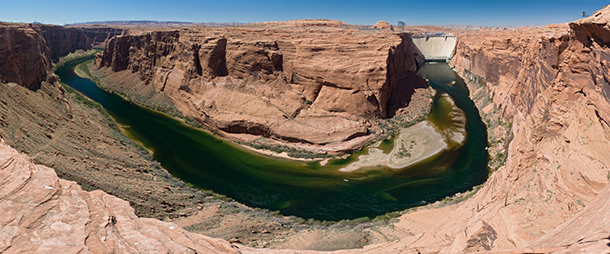
The Colorado River and the Glen Canyon Dam (Photo: Jim Trodel, Flickr CC BY-SA 2.0)
CURWOOD: Now, Abrahm, you're a reporter, you're not a hydrologist, you're not a fortune teller, but tell me, with the trend of climate disruption proceeding, and continuing to dry out the southwest, how realistic in your view, are these adjustments that people want to make in terms of really responding to the water shortage crisis that seems to be inevitable?
LUSTGARTEN: I think from my observations that they're happening painfully slowly, but I also think they are inevitable. This isn't hyperbole, this is actually happening, and you're seeing it right now in the southern basin where California, Arizona and Nevada are voluntarily coming to the table and reaching an agreement to voluntarily give up part of their share of the Colorado River, just to try to preserve Lake Mead. So, for California, especially, this is extraordinary. California holds a very senior legal position. It guaranteed to get its water, no matter what, out of the Colorado River Basin. The fact that its at the table volunteering to give some of it up is historically unprecedented and I think shows how deeply concerned these states are that the Colorado will actually dry up and if it's not managed carefully, that will happen. It's almost inevitable.
CURWOOD: Abrahm Lustgarten is an environmental reporter with ProPublica. Abrahm, thanks for joining us again.
LUSTGARTEN: Thanks so much for having me.
Links
Read Abrahm’s original story here
Read more of Abrahm’s series “Killing the Colorado”
Listen to another LOE interview with Abrahm on “Killing the Colorado”
Living on Earth wants to hear from you!
Living on Earth
62 Calef Highway, Suite 212
Lee, NH 03861
Telephone: 617-287-4121
E-mail: comments@loe.org
Newsletter [Click here]
Donate to Living on Earth!
Living on Earth is an independent media program and relies entirely on contributions from listeners and institutions supporting public service. Please donate now to preserve an independent environmental voice.
NewsletterLiving on Earth offers a weekly delivery of the show's rundown to your mailbox. Sign up for our newsletter today!
 Sailors For The Sea: Be the change you want to sea.
Sailors For The Sea: Be the change you want to sea.
 The Grantham Foundation for the Protection of the Environment: Committed to protecting and improving the health of the global environment.
The Grantham Foundation for the Protection of the Environment: Committed to protecting and improving the health of the global environment.
 Contribute to Living on Earth and receive, as our gift to you, an archival print of one of Mark Seth Lender's extraordinary wildlife photographs. Follow the link to see Mark's current collection of photographs.
Contribute to Living on Earth and receive, as our gift to you, an archival print of one of Mark Seth Lender's extraordinary wildlife photographs. Follow the link to see Mark's current collection of photographs.
 Buy a signed copy of Mark Seth Lender's book Smeagull the Seagull & support Living on Earth
Buy a signed copy of Mark Seth Lender's book Smeagull the Seagull & support Living on Earth

